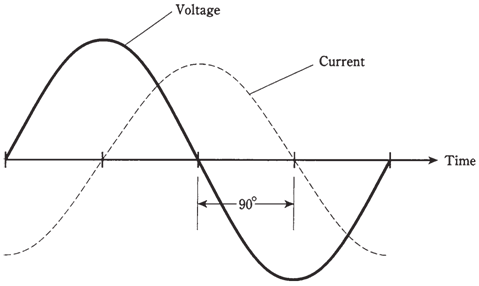Current lags voltage:
Inductance stores electrical energy as a magnetic field. When the voltage is placed across the coil, it takes awhile for current to build up to full value.
When alternating current is placed across a coil, the current lags the voltage in phase.
Pure inductance
Assume that you place an alternating current voltage across a low-loss coil, with a frequency high enough such that the inductive reactance, XL, is much larger than resistance, R. In this case, the current is one quarter of the cycle behind the voltage. That is, current lags the voltage by 90 degrees.
At low frequencies, large inductances are normally required in order for this current lag to be the full 1⁄4 cycle. This is because any coil has some resistance; no wire is perfect conductor. If some wire were found which had a mathematically zero resistance, and if the coil of any size were wound from this wire, then the current would lag the voltage by 90 °in this inductor, no matter what the alternating current frequency.
When value of XL is large compared with the value of R in the circuit-that is, when there is essentially pure inductance-the vector in RL plane points straight up along XL axis. Its angle is 90 °from the R axis, which is considered zero line in the RL plane.

Figure-- In a pure inductance, the current lags the voltage by 90 °.